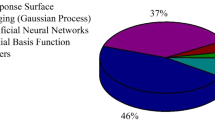Abstract
In electronic circuit design, preliminary analyses of the circuit performances are generally carried out using time-consuming simulations. These analyses should be performed as fast as possible because of the strict temporal constraints on the industrial sector time to market. On the other hand, there is the need of precision and reliability of the analyses. For these reasons, there is more and more interest toward surrogate models able to approximate the behavior of a device with a high precision making use of a limited set of samples. Using suitable surrogate models instead of simulations, it is possible to perform a reliable analysis in less time. In this work, we are going to analyze how the surrogate models given by the support vector machine (SVM) perform when they are used to approximate the behavior of industrial circuits that will be employed in consumer electronics. The SVM is also compared to the surrogate models given by the response surface methodology using a commercial software currently adopted for this kind of applications.



Similar content being viewed by others
Explore related subjects
Discover the latest articles, news and stories from top researchers in related subjects.References
Chang C-C, Lin C-J (2011) LIBSVM: a library for support vector machines. ACM Trans. Intell. Syst. Technol. 2:1–27. Software available at http://www.csie.ntu.edu.tw/~cjlin/libsvm/
Gorissen D, De Tommasi L, Hendrickx W, Croon J, Dhaene T (2008) RF circuit block modelling via Kriging surrogates. In: 17th international conference on microwaves, radar and wireless communications, MIKON 2008, IEEE Computer Society, New York, pp 1–4
Gorissen D, De Tommasi L, Crombecq K, Dhaene T (2009) Sequential modelling of a low noise amplifier with neural networks and active learning. Neural Comput Appl 18:485–494
Hsu CW, Chang CC, Lin CJ (2003) A practical guide to support vector classification. Technical report, Department of Computer Science and Information Engineering, National Taiwan University. http://www.csie.ntu.edu.tw/~cjlin/papers/guide/
Liu B, Zhao D, Reynaert P, Gielen G (2011) Synthesis of integrated passive components for high-frequency RF ICs based on evolutionary computation and machine learning techniques. IEEE Trans Comput Aided Des Integr Circuits Syst 30:1458–1468
Mentor Graphics Corporation, http://www.mentor.com/eldo/
Mukherjee S, Osuna E, Girosi F (1997) Nonlinear prediction of chaotic time series using support vector machines. In: Principe J (ed) Proceedings of the 1997 IEEE workshop on neural networks for signal processing VII, IEEE Computer Society, New York, pp 511–520
Müller K-R, Smola A, Rätsch G, Schölkopf B, Kohlmorgen J, Vapnik V (1997) Predicting time series with support vector machines. In: Artificial neural networks, lecture notes in computer science, vol 1327. Springer, Berlin, pp 999–1004
Myers R, Montgomery D, Anderson-Cook C (2009) Response surface methodology: process and product optimization using designed experiments. Wiley series in probability and statistics. Wiley, New York
MunEDA inc (2012) WiCkeD, a tool suite for nominal and statistical custom IC design. http://www.muneda.com/Products/
Schölkopf B, Smola A (2002) Learning with kernels: support vector machines, regularization, optimization, and beyond. MIT Press, Cambridge
Sun W, Tay A, Vedantam S (2005) Simulation-based design optimization of solder joint reliability of wafer level copper column interconnects. In: Mui YC (ed) Proceedings of 7th electronic packaging technology conference, EPTC 2005, vol 2. IEEE Computer Society, New York, pp 444–450
Suykens J (2001) Nonlinear modelling and support vector machines. In: Proceedings of the 18th IEEE instrumentation and measurement technology conference, IMTC 2001, vol 1. pp 287–294
Vapnik V (1998) Statistical learning theory. Wiley, New York
Wen S, Zeng Z, Huang T, Bao G (2013) Robust passivity and passification for a class of singularly perturbed nonlinear systems with time-varying delays and polytopic uncertainties via neural networks. Circuits Syst Signal Process 32:1113–1127
Wen S, Zeng Z, Huang T (2013) Associative learning of integrate-and-fire neurons with memristor-based synapses. Neural Process Lett 38:69–80
Yelten M, Franzon P, Steer M (2011) Surrogate-model-based analysis of analog circuits—Part I: variability analysis. IEEE Trans Device Mater Reliab 11:458–465
You H, Yang M, Wang D, Jia X (2009) Kriging model combined with latin hypercube sampling for surrogate modelling of analog integrated circuit performance. In: Proceedings of the 10th international symposium on quality of electronic design, ISQED 2009, IEEE Computer Society, New York, pp. 554–558
Zhang P, Breitkopf P, Knopf-Lenoir C, Zhang W (2011) Diffuse response surface model based on moving Latin hypercube patterns for reliability-based design optimization of ultra-high strength steel NC milling parameters. Struct Multidiscip Optim 44:613–628
Acknowledgments
This work has been partially funded by the European Union, ENIAC Joint Undertaking, in the MODERN project (ENIAC-120003).
Author information
Authors and Affiliations
Corresponding author
Rights and permissions
About this article
Cite this article
Ciccazzo, A., Pillo, G.D. & Latorre, V. Support vector machines for surrogate modeling of electronic circuits. Neural Comput & Applic 24, 69–76 (2014). https://doi.org/10.1007/s00521-013-1509-5
Received:
Accepted:
Published:
Issue Date:
DOI: https://doi.org/10.1007/s00521-013-1509-5




